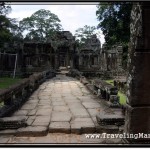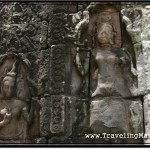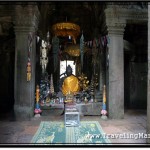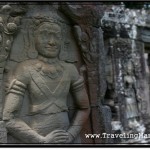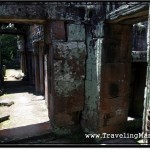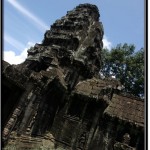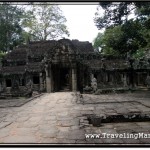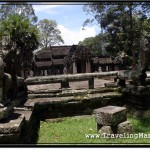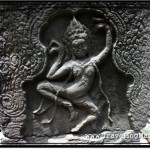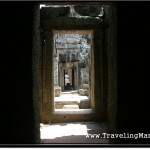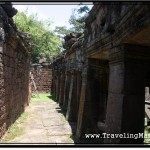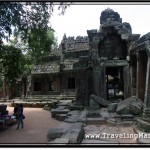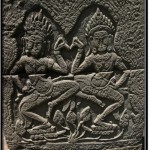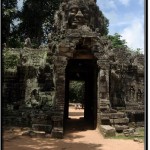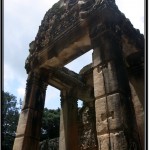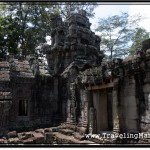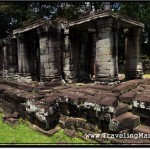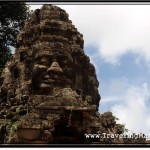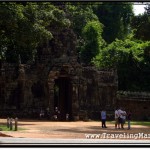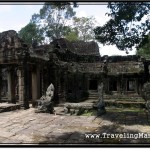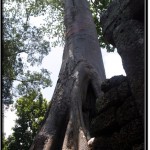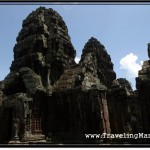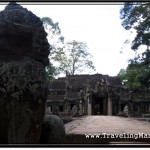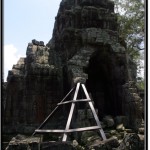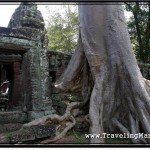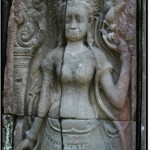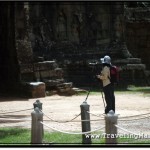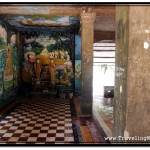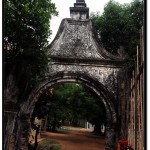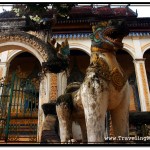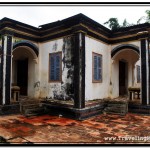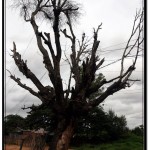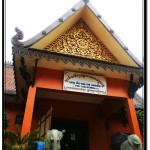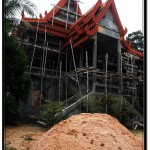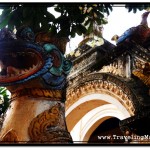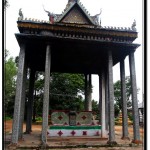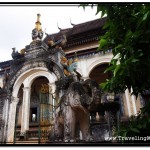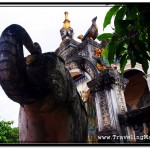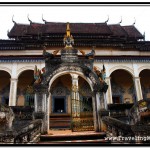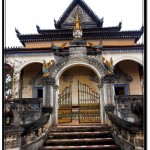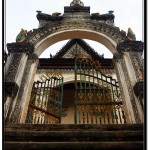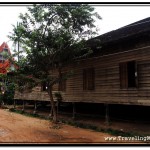The mystery surrounding Banteay Kdei temple is intriguing. Because a marker stele that would contain information about who built the temple and why has never been found, all we can do is guess. What we do know is that Banteay Kdei was constructed over a site of a smaller temple and served as a monastery for the monks during the reign of Jayavarman VII. His successor, king Jayavarman VIII vandalized Buddha images installed within during Jayavarman VII in an attempt to promote Hinduism. The photo gallery below contains pictures of Banteay Kdei I took in September 2009.
Tag: Buddhist
Preah Ngok
To the north-west of majestic Bayon temple is a small Buddhist shrine called Preah Ngok (sometimes spelled as Preah Ngoc). Even though small in overall size, it houses a rather large statue of Buddha sitting with his legs crossed and eyes only slightly open. The shrine appears to be reasonably modern, but the statue itself is believed to have come from late Angkorian era. Some say the statue has been there since the 13th century even though the chapel itself has been rebuilt several times over the centuries.
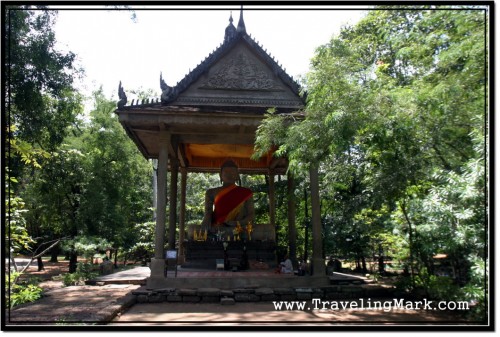
Because of its small size and apparent insignificance, the Preah Ngok shrine is missed by most visitors to Angkor. I had the whole thing for myself when I made my brief pause to take a few pictures of it, however a few Cambodian nuns sporting shaved heads and white robes kept me company. Through my own eyes, the most significant part of Preah Ngok appeared to be its similarity to more famous shrine called Tep Pranam which is located just north of the Terrace of the Leper King and aside from looking strikingly similar, it also houses a statue of Buddha that looks virtually identical to that of Preah Ngok.
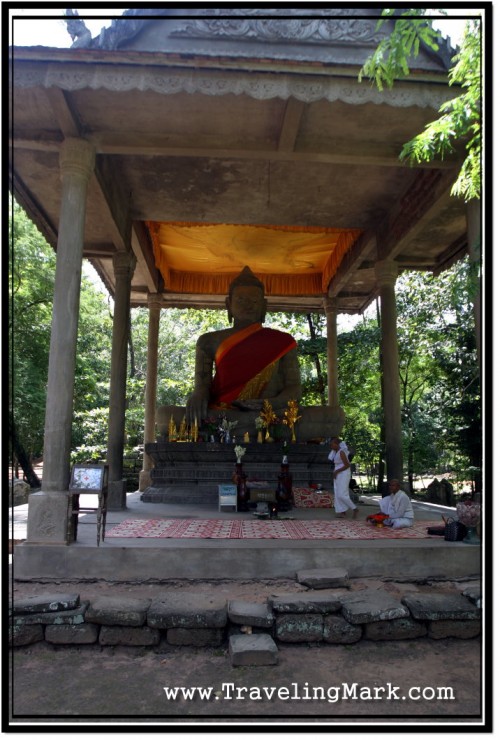
I don’t know the reason behind such similarities and I’m quite likely the only person in the world who noticed that. None of the locals I spoke with seemed to have noticed or cared and none of the guide books to Angkor ever compared the two. But that’s probably because none of the guide books ever mentions Preah Ngok in the first place.
Bakan – The Principal Sanctuary of Angkor Wat
Bakan is the name of what used to be the principal sanctuary of Angkor Wat. It is the summit of Angkor Wat’s central temple, the highest of temple’s three galleries and the uppermost point of world’s largest religious complex. Unfortunately for me, access to Bakan was prohibited at the time of my visit to Angkor Wat due to ongoing construction and restoration work on the temple. This basically means that I will be coming back to Cambodia at some point in my life and hopefully by then the access will be restored so that my Exploring Angkor Wat experience is complete.
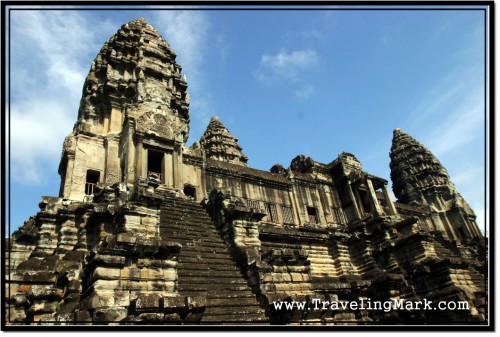
Just as it is with other Angkor Wat sanctuaries, galleries and libraries, Bakon has a doorway at each cardinal point. Scholars tend to think that Bakon originally housed a statue of Vishnu which is currently located at the “Sanctuary of the Royal Ancestor” (locally known as Kuk Ta Reach) in the southern part of the west wing of the exterior wall.
When Angkor Wat became a centre of Theravada Buddhist pilgrimage, the doorways were sealed with newly constituted sandstone walls and statues of standing Buddha were carved into them. Bakan remained sealed off like that until 1908 when archaeologists re-opened the southern doorway to gain access to the sanctuary.
Upon entrance, the archaeologists found several sculpting-art fragments of which two seemed of particular importance: a statue of Buddha seated on a naga (which is now venerated in Bakan’s eastern gallery) and a rectangular object made of stone which is believed to have served as a sarcophagus (for god-king Suryavarman II? Could that explain why Angkor Wat was built facing west?). Similar objects in which a corpse would have been laid in a foetal position were also found in other Angkorian temples.
Some of the inscriptions at Bakan and Preah Poan (Hall of the Thousand Buddhas) indicate that the transformation of Angkor Wat from Hindu into a Buddhist sanctuary took place in the late 16th century and was carried out on king’s order (whose court was already in Phnom Penh). This theory is further supported by the style of Buddha statues found within the blocked off Bakan sanctuary.
I have not been lucky enough to explore Bakan with my own eyes, but I understand it shelters four statues of Buddha, each facing different cardinal point. The Buddha of the future (Maitreya), which symbolizes peaceful transformation of Angkor Wat from the Brahmanic sanctuary into a Buddhist stupa is enclosed within garbha, the matternal matrix which the four Buddhas surround. There must be some truly spectacular view from Bakan, I have to come back!
Live Birds for Sale
The Pchum Ben Festival of the Dead was well under way when I took my Vietnamese friend Ha to the Royal Independence Gardens to enjoy the shriek of the Flying Bats with me. Because Pchum Ben is a major festival in Cambodia, both Preah Ang Chek Preah Ang Chorm Shrine and Ya Tep Shrine were very busy with hundreds of people coming in and out all the time. As it goes in Cambodia, where there is a group of people, there are street vendors offering various decorative and spiritual items for sale. Aside from pretty flower wreaths, one of the most offered articles by these temples were live birds and other live animals for sale.
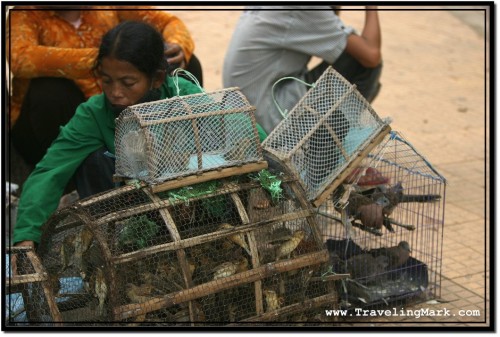
I found this extremely disturbing and saddening. I don’t know how live birds sales go together with principles of Buddhism, but Cambodian Buddhists take great pride in trapping live animals, keeping dozens of them cramped in small cages and selling them for profit to other Buddhists who come to the Buddhist temple to worship the statues of Buddha. From what I’ve noticed, people buy these live birds, keep them clenched between their palms and close to their mouth while they silently utter their prayers (or wishes?) and release them with a beaming smile afterwards.
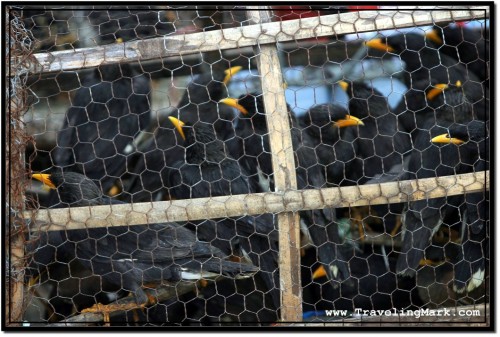
This act of release is what matters, I suppose. You can see the obvious spark in their eyes as they are doing it, however what they don’t realize is that in order to release the bird, that poor animal needs to be caught and caged first. But the saddest part happens shortly after the release. These birds have been kept in overcrowded cages, having no room to stretch their wings, often bleeding, suffocating or getting trampled by other birds – all that on top of starvation and dehydration because they are not fed which renders them unable to properly take flight after the release. As a result, you see those birds released, they take off and attempt to fly but hit the ground very quickly. Defeated and at the end of their strength, they helplessly die shortly after release. Only few are well enough to actually go and enjoy the freedom again. Those are presumably the lucky ones that get purchased before they are in the cage for too long.
Short walk across the fields surrounding the temples offers clear picture of what happens to the majority of the birds upon release. You can’t take two steps without stepping on a dead bird. It’s a very sad sight that makes whole purpose of “releasing” a life into the wild a complete joke.
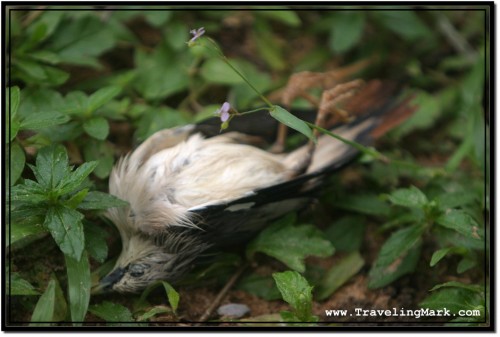
I have seen young boys walking around with long stick, poking them with great thrusts into bushes. Then I saw the same boys walking towards the women sitting at the temple with cages full of live birds for sale, delivering another captive to join the others. I don’t know how they catch those birds with just the sticks, but they must have the means. The thought of hurting an animal is very saddening to me so I never actually wanted to see this in action. However I do think those birds suffer some trauma during the capture which could also be the cause of excessive bleeding in the cage and premature death.
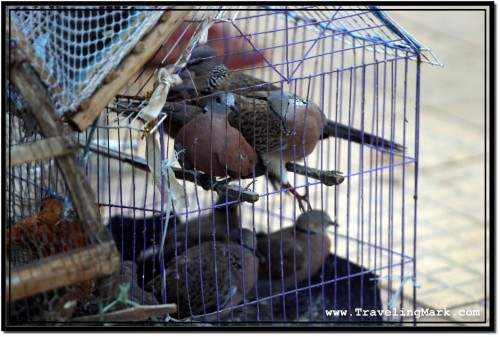
The worst thing about this whole ordeal is that Cambodians take great pride in “releasing” those live birds. Nobody seemed bothered by the fact that those living creatures suffer a great deal while they are kept in horrible conditions which affect their ability to fly and result in near certain death. Shockingly enough, aside from having live birds for sale, women with cages also sell other live animals, such as turtles. I don’t know what exactly is done with turtles after they are sold, but I don’t expect much. They are likely starved to death as they are piled in buckets on top of one another without water or food. I am not a Buddhist expert, but whatever divinity the Cambodians are trying to impress with these acts, I’m pretty sure that it’s not working. If anything, it has the opposite effect. Live and let live, the principle on which Buddhism was founded is directly breached and crapped upon by everyone who buys or sells a live bird like this. You don’t have to be an expert to understand this.
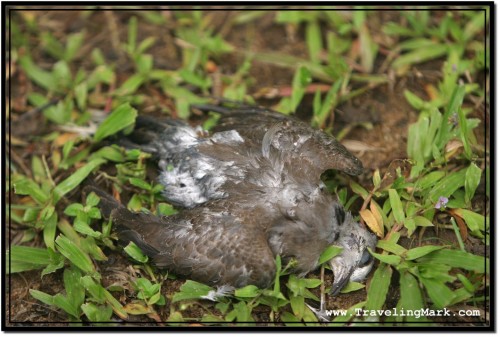
Shrine to Ya-Tep in Siem Reap
The Ya-Tep Shrine is unique in a way that it’s built right in the middle of a major road passing through Siem Reap (National Highway #6) so the road splits to go around it. Since Ya-Tep Shrine is a small structure, it only creates an effect of a traffic circle, not any major detours. Despite its small size, it’s a busy shrine that enjoys immense popularity among local Khmer people. It is said that the statue of Ya Tep that is housed within the shrine is a powerful spirit locally known as Neak-Ta. Neat-Ka spirits are localized, meaning that they protect the land where they are located and the people who live in the area. Ya Tep spirit is also believed to bring good luck to people playing the lottery so the shrine gets particularly busy on days of the draw.
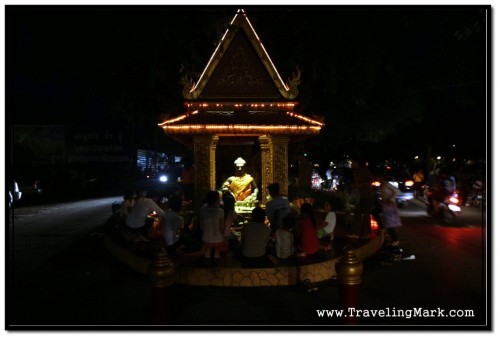
While Ya-Tep Shrine is a standalone unit that’s not part of anything bigger, it is located right between two important landmarks of Siem Reap – Royal Residence is to the south of the shrine and Preah Ang Chek Preah Ang Chorm Shrine to the north. Ya-Tep Shrine is basically right in the middle of the road that separates these two.
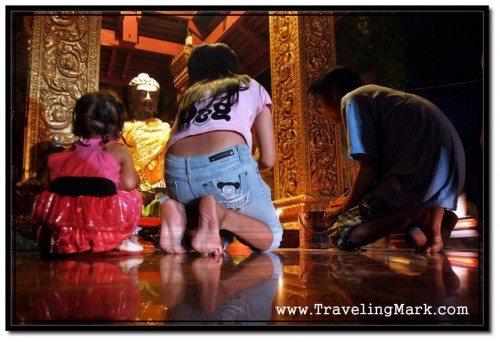
The night when I discovered majestic Flying Foxes in the Royal Independence Garden and stayed to take pictures of people bringing offerings for the dead, the Buddha and the Monks since it was the beginning of Pchum Ben Festival was also the night I first saw Ya-Tep Shrine. Well, no kidding since it’s only half the road across. Local Buddhists who paid a visit to Preah Ang Chek Preah Ang Chorm Shrine also stayed for a player and burned incense sticks before the statue of Ya-Tep.
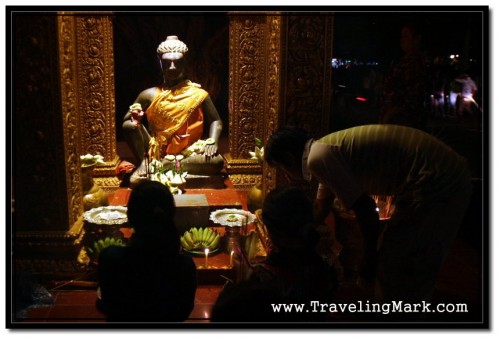
The popularity and high regard of Ya-Tep Shrine was truly evident. Each time I would be passing by on my bad ass bicycle, whether it was during the day or after dark there would be people kneeling and praying before the statue of their local protector. Speed bumps to the west of the shrine slowed down the traffic so vehicles don’t run into the island housing the shine or people who frequently come to the shrine to pray. Sadly, because of close proximity of several major landmarks, poshy hotels (Raffles Grand Hotel D’Angkor and Victoria Angkor Hotel) and Angkor Shopping Center, the area is overrun with Tuk Tuk drivers who will do their best to annoy the heck out of you while you are enjoying the sweet shriek of gianormous Fruit Bats. Ahh well… Tuk Tuk drivers, the plague of Cambodia.
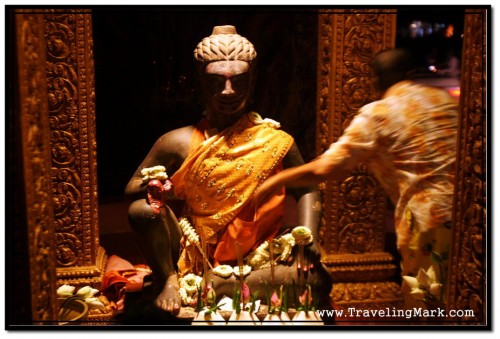
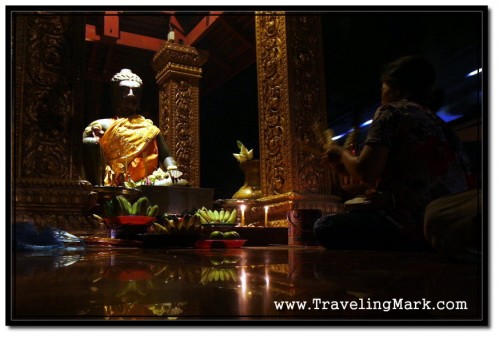
Pchum Ben Festival in Cambodia – Feeding the Spirits of the Dead
As I was receiving my introduction to Buddhism, I was told about the reason why Wat Preah Prom Rath pagoda was so full of people, why traditional Khmer music was being played from a loudspeaker why there was so much food all over the place. It was the first day of Pchum Ben Festival, which was loosely translated to me as The Festival of the Dead or sometimes as The Festival of the Souls (or spirits).
Pchum Ben is a Buddhist Festival but even though Cambodia is surrounded by other Theravada Buddhist nations, Pchum Ben is only celebrated in Cambodia and nowhere else. Pchum Ben Festival celebrations last for 15 days with final, culminating day falling on the 15th day of the 10th month of the Khmer calendar. Granted, Khmer calendar is different from the Gregorian one which is the one used by western countries so even though it was the beginning of September, the Pchum Ben Festival has already started.
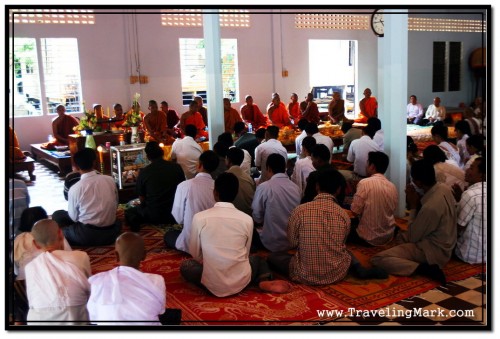
The most prominent observation a foreigner notices during Cambodian Pchum Ben Festival is the fact that it involves a lot of food. You see Khmer families coming to temples and pagodas carrying dishes with food which they arrange along the walkways while they spend hours chanting prayers inside temples, kneeling before statues of Buddha. As it was explained to me, the food is meant for the dead. The premise of Pchum Ben Festival is to feed the spirits of the dead. Cambodians firmly believe that the act of feeding the souls of their deceased predecessors will make their stay on Earth more enjoyable.
During Pchum Ben the spirits of the dead descend from the spirit world and walk the Earth. Those who are still alive prey for their souls and offer them food. As it goes with Buddhist Monks in Cambodia, people also bring food for them. The festival is very spiritual and considerably one of the most important festivals in Khmer calendar. As the history of Pchum Ben has it, the festival was originally celebrated for three months but has been shortened to 15 days as modern lifestyle makes 3 months of celebration complicated.
After me and my girl guide were done talking about the life of Buddha, we went to the prayer hall where several people were already gathered and chanted their prayers as one while their chants were played back from a loudspeaker. As confused westerner, I asked if I could join them for a prayer and take a few pictures while I was at it. There was no issue with that as Cambodians are vastly tolerant of foreigners when it comes to cultural and religious differences.
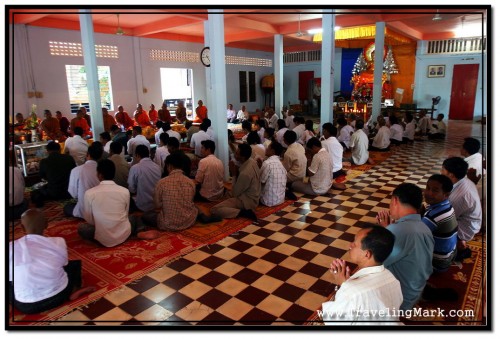
This was the beginning of Pchum Ben Festival but as it became apparent during the following 15 days, Pchum Ben was a big deal for Khmer people who take the festival very seriously and dedicate most of their focus to it while the festivities last. Even Cambodians who are otherwise non religious would prepare their food and bring the offerings to one of the temples. during Pchum Ben Little did I know at the time that the most significant events of my personal stay in Cambodia will be directly connected to Pchum Ben. Let the festivities begin!
Introduction to Buddhism and the Life of Buddha
It was a busy day but I was happy with how it all panned out. I got myself Cambodian cell number, I bought a mountain bike and baptized it by taking it for a spin across Siem Reap and to Wat Bo where I spent some time taking pictures. I was excited as I was about to have my second day of teaching English at Wat Preah Prom Rath pagoda and since it was already 4pm and the class starts at 5pm, I headed straight for Wat Preah Prom Rath. Excited about having my new ride, I was flying by Tuk Tuk drivers who only stared at me, realizing that this was one foreigner they were not gonna make any money off of. It was yet another scorching day in Cambodia but in spite of rainy season, it did not rain today at all. I was drenched in sweat and needed a break from the sun. There was no better place to go to than Wat Preah Prom Rath. Temple grounds are like a sanctuary where none of those aggressive Cambodian Tuk Tuk drivers or other touts dare to come with their malicious intentions so you can enjoy the break with peace of mind. Shaded benches are provided right across from the classrooms which is exactly where I was heading to escape the merciless sun rays.
I still had about an hour until the lecture so I was pleased to find one of my students sitting on the bench, also hiding from scorching Cambodian sun. The girl was just like most Cambodian young women – strikingly pretty. You didn’t have to ask me twice to sit next to her and engage in conversation. It was mostly me talking to myself, but we both seemed to have fun and my curiosity eventually got the best of me and I started enquiring about Buddhism and the life of Buddha. I was in predominantly Buddhist country, virtually everyone around me was a Buddhist, I was fascinated with Buddhist temples that were all over the area and my initial encounters with spirituality of Buddhism were more than positive – so it was natural that I sought answers to my many questions about Buddhism and luckily for me, the girl agreed to be my guide and introduce me to Buddhism and the life of Buddha.
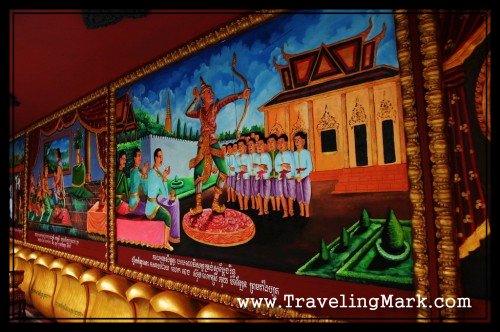
Buddha’s Life
There was a little bit of language barrier happening as my girl guide had just started to learn English so most of what she said made no sense and mostly she just repeated herself, but it was engaging nonetheless. We took our shoes off and walked straight inside the Wat Preah Prom Rath temple. As we walked around the outer wall where colorful, three-dimensional reliefs from Buddha’s life are, the girl stopped by each relief and briefly explain what the part of Buddha’s life depicted here was about. Because of limited English, all I could pick up was the story of Buddha being born and being kept within castle walls so he can become a king, as his father didn’t want him to become a holy man. But when Buddha got out of the castle and saw suffering of ordinary people and his destiny was decided.
Buddha then went to a secluded place where he lived for many days fasting. Just as he was near death from starvation, a girl found him and insisted that he eats, which saved his life. Buddha then realized that life is meant to be abundant and we shouldn’t deprive ourselves of anything but shouldn’t indulge too much either. Buddha started teaching about living “the middle way”.
The depictions of scenes from Buddha’s life involved good and bad times he went through during his life all the way until his death. My guide passionately talked about each stage of his life, but as it was hard for her to explain herself in limited English, so it was hard for me to understand what she was saying in English that was not making any sense. It was still an enjoyable and powerful introduction to Buddhism and the life of Buddha for me and I followed up on more research from this point on.
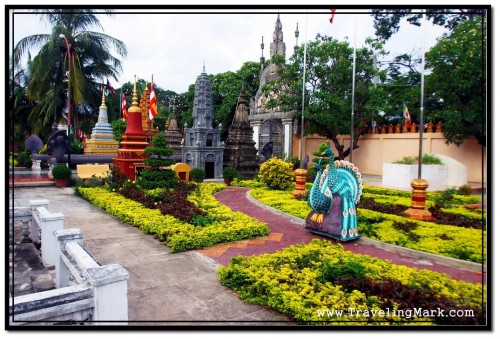
I have also asked about Stupas as the purpose of those was not clear to me. She was the first person to explain to me the meaning of Stupas and what they are used for. I did not see them as majestic monuments anymore, I actually knew what they were form now on.
Oddly enough, we both went to the classroom to attend the lesson and this was the last time I’ve seen that girl. During subsequent three months of my stay in Cambodia, she has not shown up for another lesson in the class. I do not know whether it had anything to do with me or not, but it was odd. Afterall, the hour we spent together at the temple was filled with nothing more than talking. Why was this the last time she’d attend the English class with me was and remains a mystery.
Wat Bo Pagoda in Siem Reap – Photo Gallery
Buddhism Stupas
My first exposure to Stupas was at Wat Preah Prom Rath in Cambodian Siem Reap. At that time I had no idea what these monumental structures within Buddhist pagodas were and why they ranged so much in size, color and shape. It was apparent that Stupas are an important part of Buddhism, I just didn’t know what purpose they served. When I got to Wat Bo in Siem Reap, the Stupas were more mesmerizing than the temple itself. That’s also one of the main reasons why I focused on Stupas and managed to miss historically and culturally important Reamker paintings. So what exactly are those Buddhist Stupas and why you always see them at Temple grounds?
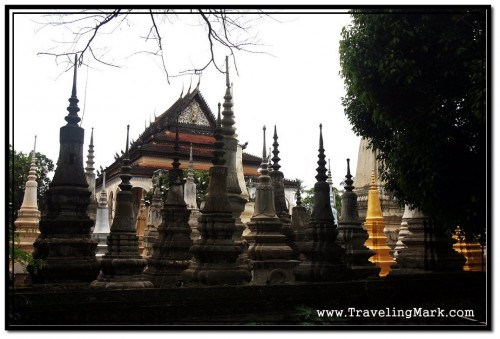
I saught answers with one of my students from the English language class at Wat Preah Prom Rath. I came to the pagoda about an hour prior to the lecture and one of the girls from the class was sitting there on the bench. Since I was entirely new to Buddhism, I asked around and she was most happy to explain. The only trick was that the class in which I was teaching was free for all, so students of all levels of English participated. The girl who was my Buddhism guide that day was a very beginner so language barrier was making it a bit difficult to understand each other.
From what I could make out, Stupas are used as graves. These monumental structures located near pagodas are basically tomb stones that house ashes of deceased Buddhists. The reason why some Stupas are bigger than other is wealth of a person or family whose ashes are housed inside. The wealthier a person, the fancier, bigger and more decorated a Stupa they can afford.
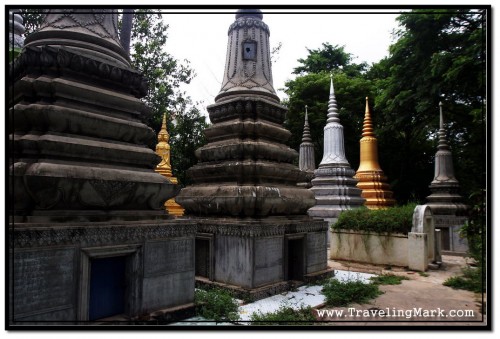
Stupas oftentimes have small entrance doorways through which ashes of other members of the same family are put inside. Through this door those who are still alive also put offerings for the dead, which include food for their journey through the afterworld, flowers, money and whatever other relics may be needed. Buddhists believe in reincarnation – death is not the end, only a transition.
In Buddhism, aside from practical use as funerary monuments, Stupas are best described as sacred monuments that symbolize enlightenment. Stupas have square bases which symbolize four immesurables as taught by Buddhism. The immeasurables are:
- Immeasurable love
- Immeasurable compassion
- Immeasurable joy
- Immeasurable equanimity
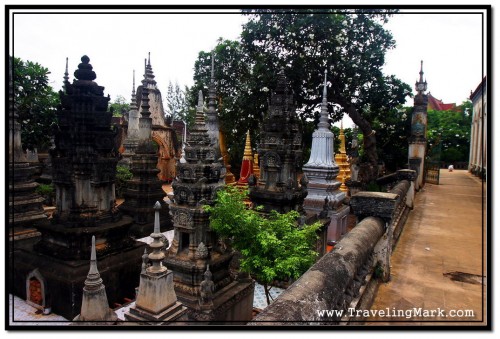
There is deep meaning to each part of Stupas. They are full of relics and holy objects, decorated with reliefs of important Buddhist events. There is powerful spirituality to each Stupa which is instantly recognized by merely looking upon one. I was drawn to those upon each encounter in Cambodia, Vietnam and Thailand. Very powerful, mesmerising monuments that establish peace and harmony and keep negative forces at bay.
RELATED GALLERY:
Wat Bo Stupas in Siem Reap, Cambodia Photo Gallery
